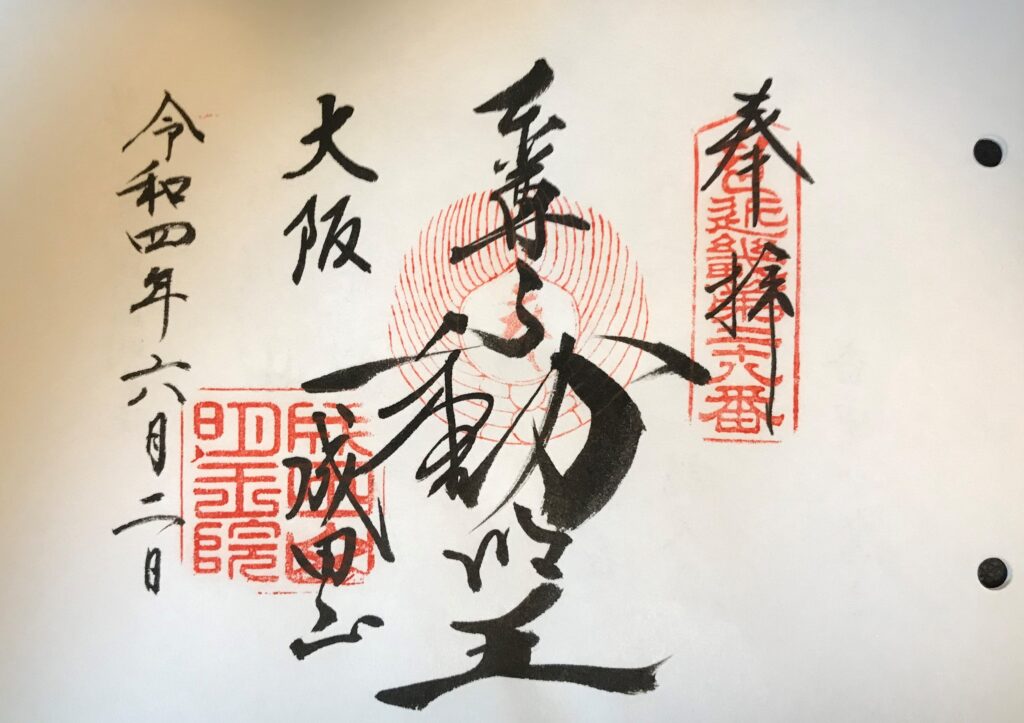近畿三十六不動尊 第28番
千葉県に成田山新勝寺がありますが、その由来をご存じの方はどれくらいいらっしゃるでしょうか。平安時代まで遡ると、当時は仏像も相手を調伏させるために戦場へ駆り出されていました。かの有名な平将門の乱が勃発した時に、朱雀天皇の密勅を受けて寛朝大僧正は不動尊像と共に関東に下りました。

そして、「国家安穏、将門降伏」にための護摩法を行い、無事に反乱は平定されました。このとき関東に降った不動尊像はその場留まり、成田山新勝寺として、今日に至っているということです。その成田山の別院として、昭和の時代に関西に建立されたのが、このお寺です。

ある意味、関東まで出かけたお不動さんが、大きな仕事を成し遂げて、そのまま関西に帰ってこなかったのが、1000年の時を経て、ようやく、その一部が関西に帰ってきたということでしょうか。仏様が戦場に滞陣するとは、いかにも物の怪や、魑魅魍魎が跋扈してた平安時代の人々が考える世界感だと思われます。

別院と家でも、参拝客が多いだけあって、規模も大きなお寺です。立派な本堂でお参りをいたしました。現在は開創90周年記念事業として、新しい山門を建築中であります。図のような立派な山門ができる様なので、完成したら、また見に来たいと思います。(完)

成田山不動尊の御宝印


大阪のお土産

価格:5,980円
(2022/1/2 18:24時点)
感想(2件)
Naritasan Fudoson Fudoson Pilgrimage
Kinki Sanjuroku Fudoson No. 28
Naritasan Shinsho-ji Temple is located in Chiba Prefecture, but how many of you know its origin? In those days, Buddhist statues were sent to battlefields to subdue their opponents, dating back to the Heian period (794-1185). When the famous Taira-no-Masakado Rebellion broke out, High Priest Kancho went to the Kanto region with a statue of Fudo under secret orders from Emperor Suzaku.
He performed a gomadabo (prayer ritual) for “national peace and the surrender of Taira no Masakado,” and the rebellion was safely pacified. The statue of Fudo that was sent down to the Kanto region at that time remained there and has been renamed Naritasan Shinshoji Temple to this day. This temple was built in Kansai in the Showa period (1926-1989) as a branch temple of Naritasan.
In a sense, it is as if a part of the spirit of Fudo-san, who traveled to the Kanto region to accomplish a great task and did not return to Kansai, has finally returned to Kansai after a lapse of 1,000 years. The idea of a Buddha staying in the battlefield seems to be the worldview of the people of the Heian period, when the spirits of monsters and evil spirits of rivers and mountains abounded.
Even though it is a branch temple, it is a large temple with a lot of worshippers. I paid my respects in the magnificent main hall. Currently, a new gate is under construction to commemorate the 90th anniversary of the temple’s founding. I would like to visit the temple again when it is completed. (End)
Pèlerinage à Naritasan Fudoson Fudoson
Kinki Sanjuroku Fudoson No. 28
Le temple Naritasan Shinsho-ji est situé dans la préfecture de Chiba, mais combien d’entre vous connaissent son origine ? À l’époque, les statues bouddhistes étaient envoyées sur les champs de bataille pour soumettre leurs adversaires. Cela remonte à la période Heian (794-1185). Lorsque la célèbre rébellion de Taira-no-Masakado a éclaté, le grand prêtre Kancho s’est rendu dans la région du Kanto avec une statue de Fudo, sur ordre secret de l’empereur Suzaku.
Il a effectué un gomadabo (rituel de prière) pour “la paix nationale et la reddition de Taira no Masakado”, et la rébellion a été pacifiée. La statue de Fudo qui avait été envoyée dans la région du Kanto à cette époque est restée sur place et a été rebaptisée temple Naritasan Shinshoji jusqu’à ce jour. Ce temple a été construit dans le Kansai pendant la période Showa (1926-1989) en tant que succursale du temple Naritasan.
En un sens, c’est comme si une partie de l’esprit de Fudo-san, qui s’était rendu dans la région du Kanto pour accomplir une grande tâche et n’était pas revenu au Kansai, était finalement revenu au Kansai après un laps de temps de 1 000 ans. L’idée d’un Bouddha séjournant sur le champ de bataille semble être la vision du monde des gens de la période Heian, lorsque les esprits des monstres et les mauvais esprits des rivières et des montagnes abondaient.
Même s’il s’agit d’un temple secondaire, c’est un grand temple avec beaucoup de fidèles. J’ai présenté mes respects dans le magnifique hall principal. Actuellement, une nouvelle porte est en construction pour commémorer le 90e anniversaire de la fondation du temple. J’aimerais visiter à nouveau le temple lorsqu’il sera terminé. (Fin)
